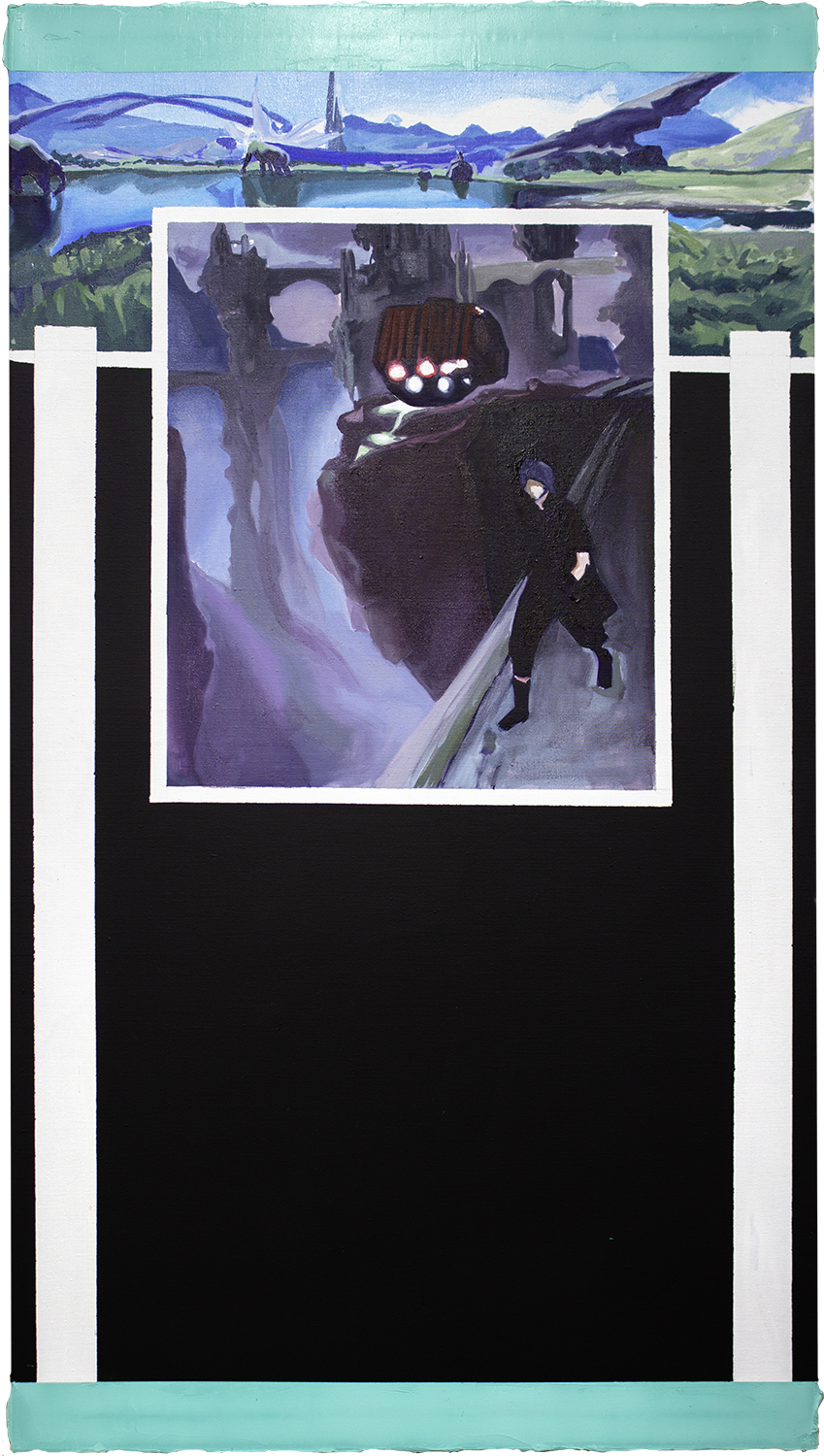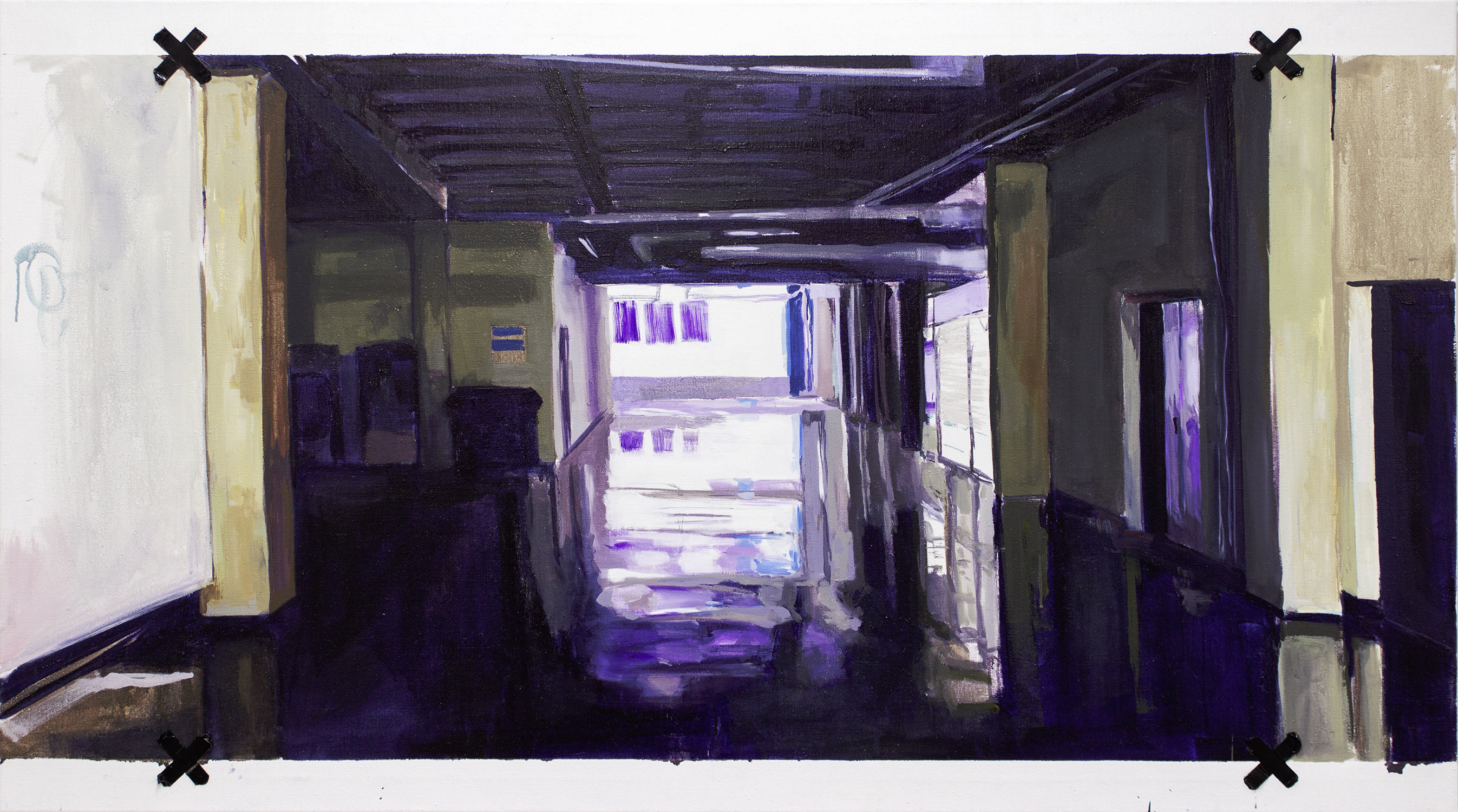Virtual tour: drag to look around, click the spots on the ground to move
Malte Frey & Julian Reiser
Blender
29.01.2021 - 28.02.2021
Front Gallery is pleased to present the show „Blender“ by painters Malte Frey and Julian Reiser.
The exhibition contains pieces of Frey and Reiser from 2020, ‚blended‘ in a mutual context.
Additionally, the show’s title not only refers to the act of mixing but also draws from the German
„Blender“ meaning somebody phony, imposing: a fake.
Dealing with the state of the prominent art world and the constant confusion of virtual and real, the
show therefore hints at the everlasting question of something’s origin, meaning and fundamentally
worth.
In the figurative motives of Frey’s paintings and sculptures, scenes taken from daily life and of open world computer games are joined by a traditional view on realism. In the paintings one recognizes a certain kind of familiarity with the world. The artist shows us a scenery which we see every day, even if we don’t always pay attention to it. At first glance one could say Frey paints reality. But when you take a closer look, you notice that something is different. There is a certain distance and a certain estrangement to the painting. The artist seems to be taking a look at the world from a strange angle, which does not correspond to our everyday experience. Frey surrounds images with more images and also stresses the physical qualities of the paint. Thereby he constructs formalistic paintings that leave open the possibility of narration. The paintings and sculptures are composed of different layers of reality, which are in the visual sense, but also in the material sense, connected to each other. The art of Frey is not a representation of the world or a mirror, but rather a view into the world. He describes the world which is familiar to us in a relatively realistic way, but at the same time distends it, thus making it new and strange: like a dream, which has a logical structure but is experienced as absurd. Frey’s paintings are at the same time realistic and abstract. The motifs are recognizable, but the paint handling and the way the pictures are composed are abstract. In his paintings he is using a very strong color spectrum, which, together with the strong contrast, gives the paintings a very vivid impression. Through the merging of a detailed representation of the object with the representation of an image in a computer game, the materiality of the object is reduced to the status of a “geometric ornament”. In his sculptures, he operates with similar processes, by cutting up one form to create another. And in doing so, he again creates a narrative space, which he fills with his illustrations. Frey’s work oscillates between a realistic and a surrealistic language which also leads to a deconstruction of the picture plane, and which recalls the former art historical strategy of collage. With his work, the artist Malte Frey is, in a certain way, always in the search for a new medium. In his works, Frey questions the status of painting and sculpture in the digital age - “is the painting dead? Is the sculpture dead? No, it’s just different!” - and explores the possibilities of an inherent pictorial language.
Reiser shows his newest series of drawings titled “When the money disappears”. Each paper is parted through the middle by a fold. The left sides of all papers are black, only the sheen of the graphite used for the drawings showing the traces of the artist’s hand. On the right sides we see interior scenes that grow increasingly dark in the later drawings. The right slowly converges to the image on the left sides, the last drawing of the series shows only two black squares. The rooms we see are decorated with artworks from blue chip artists. At least that is what the titles of Reise’s drawings imply. In fact they are pastiches mounted into high class living environments. This is how the artist comments on the fetish of the art world, mimicking the values of a globalised world. In Reiser’s drawings the different worlds of left and right seem to overlap. The artist uses the fold as a metaphor for a hidden difference in level, for a rift between appearances and reality. The fold is at the same time an optical illusion that visualises the conflict between the image and the object, between art and reality. The relationship between the two sides of the folded paper also refer to anti-matter, black holes and other parallel universes or to the infinitely small. The question is if the differences between the two sides are only apparent or if they are part of an essential and structural rift. This is reinforced by the unusual frames the drawings are displayed in. These too are folded down the middle and the two sides bend in on each other like a closing book. “When the money disappears” is a title that may refer to the current global economic and political crises, but maybe the events in the drawings are premonitions of things yet to come. The artworks by the blue chip artists are pastiches that only exist in the world of the paper. The title is a warning signal that the value of art in a globalised world can change at any time. That art can be devalued to the point where it no longer has any value at all. The series is a critical comment on the art world and its inherent structures including the art market, contemporary art, the gallery system, institutions and museums. It shows how artworks and artists are part of a globalised economic system. But it is also a critique of the system that turns art into a commodity and turns artists into brands. The work is about the relationship between art and reality, but also about the way art is used to decorate living spaces, to signal wealth and social status.
In the figurative motives of Frey’s paintings and sculptures, scenes taken from daily life and of open world computer games are joined by a traditional view on realism. In the paintings one recognizes a certain kind of familiarity with the world. The artist shows us a scenery which we see every day, even if we don’t always pay attention to it. At first glance one could say Frey paints reality. But when you take a closer look, you notice that something is different. There is a certain distance and a certain estrangement to the painting. The artist seems to be taking a look at the world from a strange angle, which does not correspond to our everyday experience. Frey surrounds images with more images and also stresses the physical qualities of the paint. Thereby he constructs formalistic paintings that leave open the possibility of narration. The paintings and sculptures are composed of different layers of reality, which are in the visual sense, but also in the material sense, connected to each other. The art of Frey is not a representation of the world or a mirror, but rather a view into the world. He describes the world which is familiar to us in a relatively realistic way, but at the same time distends it, thus making it new and strange: like a dream, which has a logical structure but is experienced as absurd. Frey’s paintings are at the same time realistic and abstract. The motifs are recognizable, but the paint handling and the way the pictures are composed are abstract. In his paintings he is using a very strong color spectrum, which, together with the strong contrast, gives the paintings a very vivid impression. Through the merging of a detailed representation of the object with the representation of an image in a computer game, the materiality of the object is reduced to the status of a “geometric ornament”. In his sculptures, he operates with similar processes, by cutting up one form to create another. And in doing so, he again creates a narrative space, which he fills with his illustrations. Frey’s work oscillates between a realistic and a surrealistic language which also leads to a deconstruction of the picture plane, and which recalls the former art historical strategy of collage. With his work, the artist Malte Frey is, in a certain way, always in the search for a new medium. In his works, Frey questions the status of painting and sculpture in the digital age - “is the painting dead? Is the sculpture dead? No, it’s just different!” - and explores the possibilities of an inherent pictorial language.
Reiser shows his newest series of drawings titled “When the money disappears”. Each paper is parted through the middle by a fold. The left sides of all papers are black, only the sheen of the graphite used for the drawings showing the traces of the artist’s hand. On the right sides we see interior scenes that grow increasingly dark in the later drawings. The right slowly converges to the image on the left sides, the last drawing of the series shows only two black squares. The rooms we see are decorated with artworks from blue chip artists. At least that is what the titles of Reise’s drawings imply. In fact they are pastiches mounted into high class living environments. This is how the artist comments on the fetish of the art world, mimicking the values of a globalised world. In Reiser’s drawings the different worlds of left and right seem to overlap. The artist uses the fold as a metaphor for a hidden difference in level, for a rift between appearances and reality. The fold is at the same time an optical illusion that visualises the conflict between the image and the object, between art and reality. The relationship between the two sides of the folded paper also refer to anti-matter, black holes and other parallel universes or to the infinitely small. The question is if the differences between the two sides are only apparent or if they are part of an essential and structural rift. This is reinforced by the unusual frames the drawings are displayed in. These too are folded down the middle and the two sides bend in on each other like a closing book. “When the money disappears” is a title that may refer to the current global economic and political crises, but maybe the events in the drawings are premonitions of things yet to come. The artworks by the blue chip artists are pastiches that only exist in the world of the paper. The title is a warning signal that the value of art in a globalised world can change at any time. That art can be devalued to the point where it no longer has any value at all. The series is a critical comment on the art world and its inherent structures including the art market, contemporary art, the gallery system, institutions and museums. It shows how artworks and artists are part of a globalised economic system. But it is also a critique of the system that turns art into a commodity and turns artists into brands. The work is about the relationship between art and reality, but also about the way art is used to decorate living spaces, to signal wealth and social status.
Text and Images: Front gallery, 2021







